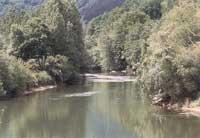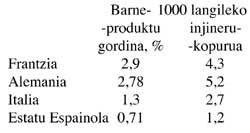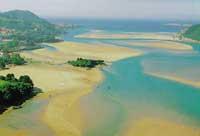Bidasoa, end of myth
1996/02/01 Zabala, Joserra Iturria: Elhuyar aldizkaria
Until recently, many areas of Euskal Herria were considered sacred or at least places of great respect. As the controversial thinker and biochemist Rupert Sheldrake would say, place of animist culture. These were alive and human beings took them like this. There are names like Ernio, Anboto or Aizkorri. Within this group you can locate our border river, a paradise chosen by smugglers, licks and witches.
Unfortunately, after the abandonment of animism, we live in mechanism (we are animals, nature and ourselves are machines) and the mythical places of antennas that today were suitable places or, in the case of Bidasoa, another stream of water for hydraulic use. Despite the fact that its consequences had not been noticed at first too much, at last and after that the green gendarmes and trikonians were there to maintain the darkness of the margins of the Bidasoa and with the passage of the years they were constructing hydraulic centers, housings, platforms of transport and factories; the walls and canalizations built on both sides showed that the freedom of nature could definitively end.
Thus, the Bidasoa River is taking the same aspect as the rest of Euskal Herria. It is already easier than a zaguán to see the condoms or Mamut bags. In short, a modern people cannot keep the myths, because it does not give money. And what is worse, the process has only begun: The main populations of Navarre are settling industrial areas on the banks of the rivers. In the right part of Irun the same is being proposed, in addition to the nautical infrastructure and international canoeing facilities.
Finally, in Lapurdi, in the last natural corners of the river the fillings predominate. Next to them is the most terrible ghost, the project of the Bidasoa highway that will join Mugaire and Irun. The only positive element in this pessimistic scenario can be the Special Protection Plan of the Bay of Txingudi, elaborated by the Basque Government (which is also being subjected to strong pressure by the lords of the area), which, together with the estuary, allows the protection of some margins and rural areas of the river.
If the panorama is dark, the answers and solutions are not clearer. I think at this time the only way is to reconvert Bidasoa into a mythical environment, but not through ancient tales or myths, but through the data provided by scientists, which is the current religion. It will be necessary to insist that the Bidasoa River is the only place where we move to promote the survival of salmon, in which the last specimens of different species such as otter, turons and others are hidden, or in general the landscape values practically lost. In any case, and despite having the collaboration of Basajaun itself, it is a challenge, since in our country the development trend has solid roots. Urtzi and Mari, where are you?

Gai honi buruzko eduki gehiago
Elhuyarrek garatutako teknologia






